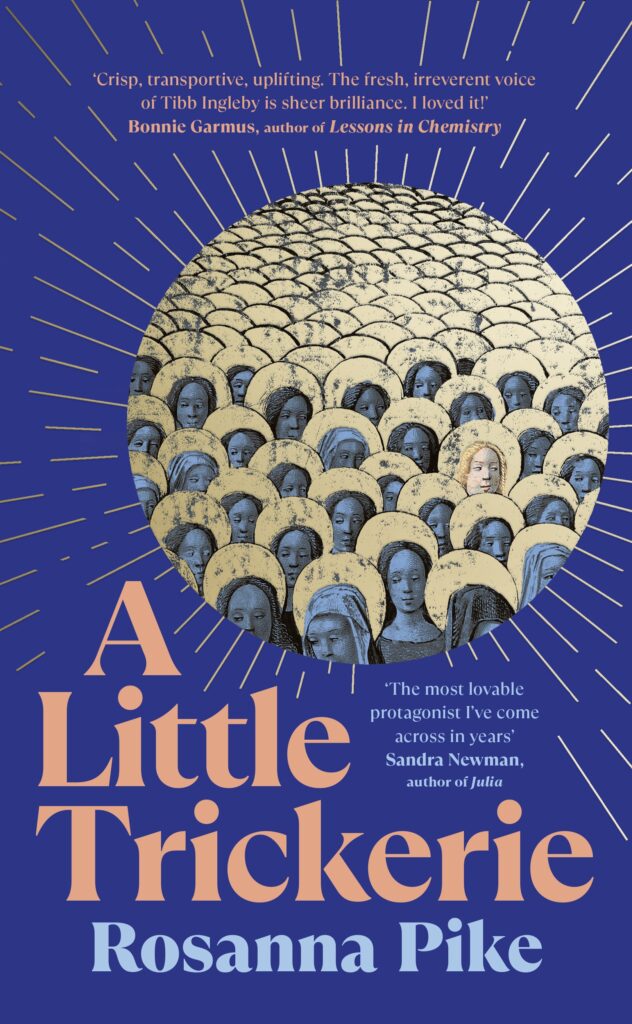Rosanna Pike’s A Little Trickerie tells the story of an audacious hoax performed by a charming vagabond on the periphery of Tudor society.
Longlisted for the 2025 Women’s Prize for Fiction, judge Bryony Gordon says: ‘I fell utterly in love with Tibb Ingleby, the heroine of this moving and funny historical novel, in which a rag-tag band of waifs and strays try to pull off the heist of the sixteenth century. Cheeky, charming and almost Chaucerian, A Little Trickerie is a joy to behold.’
To find out more about the book we spoke to Rosanna about her inspirations, writing process and favourite books.
How would you describe your book to a new reader?
Traversing the underbelly of Tudor England, we join vagrant Tibb Ingleby as she sets out in search of a better life, dodging bad memories and men who will spit you out. And since she has no interest in the big-man-God, and since she does not have shit-for-brains, when the opportunity presents itself to fool the country in a perilous hoax, she has everything to gain. Tibb’s is a story about striving for better, by hook-or-by-crook. It’s about overcoming demons, challenging authority and daring to be different.
What was the idea that sparked your novel?
The extremely brief Wikipedia page for the ‘Holy Maid of Leominster.’ I stumbled on it while I was researching for a different idea and I realised immediately that Elizabeth’s was the story I needed to be writing. A female con artist who pretended to be an angel in a church in Herefordshire, amassing a cult following and a load of money. Such an audacious hoax at a time when the Church was so powerful; I began to wonder what led this woman to risk so much.
Which part of the book did you write first? Was there a moment that clicked a lot of things in place or where you felt the strands of the book started to come together?
I challenged myself to write the story chronologically which is not my natural inclination! Tibb’s backstory in relation to her mother was always clear in my mind, but when the idea of Farmer O became fully-formed and water-tight in my head then things really fell into place. The hoax made so much sense considering the experiences Tibb had lived through.
Which part of the book was the most fun to write? Which was the most challenging?
The scenes in the church were fun – I loved exploring all the logistical nightmares of the hoax, and thinking of ways Tibb and her friends could outwit their enemies. The scenes at Mr Manners’ house were fun too as I found him such an amusing and complicated character. More broadly, it was a total joy to write in Tibb’s voice and to live inside her head. Writing the ending was the trickiest part as I wanted to keep it believable while at the same time exploring the idea of achieving the impossible in order to mirror the hoax. I played with various different ideas but ultimately I kept coming back to the same one.
What is the best piece of writing advice you have ever received?
I was told by Charlotte Mendelson that you should always know with absolute certainty how your characters would eat their peas. It made me realise that character is everything when writing fiction. Your character is the star of the show and you have to know them inside out. (Obviously Tibb would eat her peas using her hand like a shovel.)
Which female author would you say has impacted your work the most?
Gail Honeyman – I really love surprising and unique voices and I found Eleanor Oliphant so refreshing. I hadn’t met anyone like her before and I found the book very inspirational.
What is your favourite book from the Women’s Prize library and why?
Sorrow and Bliss by Meg Mason. I thought it demonstrated in such a devastating way how mental health can dictate the course of someone’s life. How it can hamper decisions and ravage relationships; or give space for joy and light. It highlighted just how vulnerable people really are when they are living at the mercy of their thoughts.
Could you reveal a secret about your creative process?
At the moment my secret is to make use of grandparents and every spare moment in the day! I have a six week old daughter and a son who is nearly two, so it can be a struggle to fit writing into the day. Luckily they have two very willing grandmas and without them I think I couldn’t have written much at all for the past two years. Nap times are useful – however short or disjointed – I make sure to still get some writing or editing done and I write in the evenings when everyone is in bed. Before I had children I used to swim lengths every day and this would be where I did my best thinking. I would think about solutions to plot issues and structural problems as I swam up and down.









